VRChances: An Immersive Virtual Reality Experience to Support Teenagers in Their Career Decisions
Abstract
1. Introduction
- RQ1: How does performing occupational tasks within VR affect teenagers’ job understanding and expectations?
- RQ2: How effective is VR in assisting teenagers with their career choices?
2. Background and Related Work
2.1. Career Choice and Decision Making
2.2. VR in Education and Training
2.3. VR Tools for Professional Training
2.4. VR Simulations for Career Guidance
3. Virtual Job Guidance
3.1. Guide Interaction
3.2. Job Scenarios
4. Study Design
4.1. Material and Setup
4.2. Expert Evaluation
4.3. User Evaluation
5. Results
5.1. Expert Review
5.2. User Job Expectations
6. Discussion
6.1. Expert Insights and User Expectations
6.2. Sentiment and Career Outlook
6.3. Limitations
7. Conclusions
Author Contributions
Funding
Institutional Review Board Statement
Informed Consent Statement
Data Availability Statement
Acknowledgments
Conflicts of Interest
Appendix A. Questionnaires
Appendix A.1. Expert Evaluation Questionnaire
| # | Question | Answer Type |
|---|---|---|
| 1 | User ID | Number |
| 2 | Age | Number |
| 3 | Gender | male, female, other |
| 4 | Level of Education | Primary education, Lower secondary education, Upper secondary education, University degree, other |
| 5 | Rate your experience in the following areas:
| 1 (very poor)–5 (very high) |
| 6 | How familiar are you with the profession of electrician? | 1 (hardly at all)–5 (very familiar) |
| 7 | What are the typical tasks an electrician has to perform? | Text |
| 8 | What skills are needed to work as an electrician? | Text |
| 9 | How do you see the job prospects for electricians? | Text |
| 10 | Do you think being an electrician is more of a job for boys, girls, or both? Give reasons for your answer. | Text |
| 11 | (Only for electricians) What is a common salary for an electrician? | Number |
| # | Question | Answer Type |
|---|---|---|
| 12 | Rate the following statements:
| 1 (strongly disagree)–5 (strongly agree) |
| 13 | What areas of the application could be improved? Do you have any other comments? | Text |
Appendix A.2. User Evaluation Questionnaire
| # | Question | Answer Type |
|---|---|---|
| 1 | User ID | Number |
| 2 | Age | Number |
| 3 | Gender | male, female, other |
| 4 | Level of Education | Primary education, Lower secondary education, Upper secondary education, University degree, other |
| 5 | Rate your experience in the following areas:
| 1 (very poor)–5 (very high) |
| 6 | How familiar are you with the profession of electrician? | 1 (hardly at all)–5 (very familiar) |
| 7 | What salary expectations do you have for the job of an electrician? | Number |
| 8 | What working time preferences would you have as an electrician? | Regular working hours, Shift work, Weekend work |
| 9 | Name the first three words that come to your mind when you think of an electrician. | Text |
| 10 | What are the responsibilities of an electrician? What do you think are the typical tasks an electrician has to do? | Text |
| 11 | What skills does an electrician need in your opinion? | Text |
| 12 | How do you see the job prospects for electricians? | Text |
| 13 | Do you think being an electrician is more of a job for boys, girls, or both? Give reasons for your answer. | Text |
| 14 | Would you like to work as an electrician? | Yes, No |
| # | Question | Answer Type |
|---|---|---|
| 15 | User ID | Number |
| 16 | How familiar are you now with the profession of electrician? | 1 (hardly at all)–5 (very familiar) |
| 17 | Name the first three words that come to your mind when you think of an electrician. | Text |
| 18 | How would you describe the work of an electrician now? | Text |
| 19 | What skills does an electrician need in your opinion? | Text |
| 20 | How do you see the job prospects for electricians now? | Text |
| 21 | Has your opinion changed as to whether being an electrician is more of a job for boys, girls, or both? | Text |
| 22 | Has what you have learned changed your opinion of electricians? If so, how? What did you find most interesting or surprising? | Text |
| 23 | Would you like to work as an electrician now? | Yes, No |
References
- Smit, S.; Tacke, T.; Lund, S.; Manyika, J.; Thiel, L. The Future of Work in Europe: Automation, Workforce Transitions, and the Shifting Geography of Employment; McKinsey Global Institute: New York, NY, USA, 2020. [Google Scholar]
- Gati, I.; Levin, N.; Landman-Tal, S. Decision-making models and career guidance. In International Handbook of Career Guidance; Springer: Cham, Switzerland, 2019; pp. 115–145. [Google Scholar]
- Ulrich, A.; Helker, K.; Losekamm, K. “What Can I Be When I Grow Up?”—The Influence of Own and Others’ Career Expectations on Adolescents’ Perception of Stress in Their Career Orientation Phase. Sustainability 2021, 13, 912. [Google Scholar] [CrossRef]
- Akosah-Twumasi, P.; Emeto, T.I.; Lindsay, D.; Tsey, K.; Malau-Aduli, B.S. A systematic review of factors that influence youths career choices—The role of culture. Front. Educ. 2018, 3, 348903. [Google Scholar] [CrossRef]
- Pottle, J. Virtual reality and the transformation of medical education. Future Healthc. J. 2019, 6, 181. [Google Scholar] [CrossRef] [PubMed]
- Górski, F.; Buń, P.; Wichniarek, R.; Zawadzki, P.; Hamrol, A. Effective design of educational virtual reality applications for medicine using knowledge-engineering techniques. EURASIA J. Math. Sci. Technol. Educ. 2016, 13, 395–416. [Google Scholar] [CrossRef]
- Lindner, P.; Miloff, A.; Hamilton, W.; Reuterskiöld, L.; Andersson, G.; Powers, M.B.; Carlbring, P. Creating state of the art, next-generation Virtual Reality exposure therapies for anxiety disorders using consumer hardware platforms: Design considerations and future directions. Cogn. Behav. Ther. 2017, 46, 404–420. [Google Scholar] [CrossRef]
- Portman, M.E.; Natapov, A.; Fisher-Gewirtzman, D. To go where no man has gone before: Virtual reality in architecture, landscape architecture and environmental planning. Comput. Environ. Urban Syst. 2015, 54, 376–384. [Google Scholar] [CrossRef]
- Choi, S.; Jung, K.; Noh, S.D. Virtual reality applications in manufacturing industries: Past research, present findings, and future directions. Concurr. Eng. 2015, 23, 40–63. [Google Scholar] [CrossRef]
- Soliman, M.; Pesyridis, A.; Dalaymani-Zad, D.; Gronfula, M.; Kourmpetis, M. The application of virtual reality in engineering education. Appl. Sci. 2021, 11, 2879. [Google Scholar] [CrossRef]
- Portelli, M.; Bianco, S.; Bezzina, T.; Abela, J. Virtual reality training compared with apprenticeship training in laparoscopic surgery: A meta-analysis. Ann. R. Coll. Surg. Engl. 2020, 102, 672–684. [Google Scholar] [CrossRef]
- Villena-Taranilla, R.; Tirado-Olivares, S.; Cózar-Gutiérrez, R.; González-Calero, J.A. Effects of virtual reality on learning outcomes in K-6 education: A meta-analysis. Educ. Res. Rev. 2022, 35, 100434. [Google Scholar] [CrossRef]
- Díaz, M.J.; Mantell, C.; Caro, I.; de Ory, I.; Sánchez, J.; Portela, J.R. Creation of immersive resources based on virtual reality for dissemination and teaching in chemical engineering. Educ. Sci. 2022, 12, 572. [Google Scholar] [CrossRef]
- Simons, A.; Wohlgenannt, I.; Zelt, S.; Weinmann, M.; Schneider, J.; vom Brocke, J. Intelligence at play: Game-based assessment using a virtual-reality application. Virtual Real. 2023, 27, 1827–1843. [Google Scholar] [CrossRef]
- Prasolova-Førland, E.; Fominykh, M.; Ekelund, O.I. Empowering young job seekers with virtual reality. In Proceedings of the 2019 IEEE Conference on Virtual Reality and 3D User Interfaces (VR), Osaka, Japan, 23–27 March 2019; pp. 295–302. [Google Scholar]
- Aurangzeb, W.; Mehmood, A.; Khan, S. Gendered Perceptions’ regarding Career Guidance Needs at Higher Education Level. Int. J. Innov. Teach. Learn. (IJITL) 2020, 6, 48–62. [Google Scholar] [CrossRef]
- Jiang, Y.; Popov, V.; Li, Y.; Myers, P.L.; Dalrymple, O.; Spencer, J.A. “It’s like I’m really there”: Using VR experiences for STEM career development. J. Sci. Educ. Technol. 2021, 30, 877–888. [Google Scholar] [CrossRef]
- Spangenberger, P.; Freytag, S.C. Career Choice of Adolescents: Can occupational VR 360-degree Videos Facilitate Job Interest? In Proceedings of the CSEDU (1), Prague, Czech Republic, 2–4 May 2020; pp. 552–558. [Google Scholar]
- Holly, M.; Pirker, J.; Resch, S.; Brettschuh, S.; Gütl, C. Designing VR experiences–expectations for teaching and learning in VR. Educ. Technol. Soc. 2021, 24, 107–119. [Google Scholar]
- Holly, M.; Habich, L.; Seiser, M.; Glawogger, F.; Innerebner, K.; Kupsa, S.; Einwallner, P.; Pirker, J. FemQuest—An Interactive Multiplayer Game to Engage Girls in Programming. In Proceedings of the 2024 IEEE Conference on Games (CoG), Milan, Italy, 5–8 August 2024. [Google Scholar]
- Holly, M.; Resch, S.; Pirker, J. An Asymmetric Multiplayer Learning Environment for Room-Scale Virtual Reality and a Handheld Device. Proc. ACM Hum.-Comput. Interact. 2023, 7, 1–19. [Google Scholar]
- Gati, I.; Kulcsár, V. Making better career decisions: From challenges to opportunities. J. Vocat. Behav. 2021, 126, 103545. [Google Scholar] [CrossRef]
- Hirschi, A.; Laege, D. The Relation of Secondary Students’ Career-Choice Readiness to a Six-Phase Model of Career Decision Making. J. Career Dev. 2007, 34, 164–191. [Google Scholar] [CrossRef]
- Feldman, D.C.; Arnold, H.J. Position choice: Comparing the importance of organizational and job factors. J. Appl. Psychol. 1978, 63, 706. [Google Scholar] [CrossRef]
- Newton, R.M.; Giesen, J.; Freeman, J.; Bishop, H.; Zeitoun, P. Assessing the reactions of males and females to attributes of the principalship. Educ. Adm. Q. 2003, 39, 504–532. [Google Scholar] [CrossRef]
- McGraw, K.; Popp, J.; Dixon, B.; Newton, D. Factors Influencing Job Choice among Agricultural Economics Professionals. J. Agric. Appl. Econ. 2011, 44, 251–265. [Google Scholar] [CrossRef]
- Bright, J.E.; Pryor, R.G.; Wilkenfeld, S.; Earl, J. The role of social context and serendipitous events in career decision making. Int. J. Educ. Vocat. Guid. 2005, 5, 19–36. [Google Scholar] [CrossRef]
- Kulkarni, M.; Nithyanand, S. Social influence and job choice decisions. Empl. Relat. 2012, 35, 139–156. [Google Scholar] [CrossRef]
- Singh, A.; Chakraborty, S.; Patoju, S.K.S. Career choices and job preferences of social entrepreneurship graduates: Implication for redefining “success” of social entrepreneurship education. Soc. Enterp. J. 2023, 19, 459–480. [Google Scholar] [CrossRef]
- Husain, F.M.; Mahfoodh, O.H.A. English for Professionals students’ perceptions of the relevance of internship to their undergraduate courses and career choices. High. Educ. Ski. Work.-Based Learn. 2021, 11, 1068–1088. [Google Scholar] [CrossRef]
- Pallavicini, F.; Pepe, A.; Minissi, M.E. Gaming in virtual reality: What changes in terms of usability, emotional response and sense of presence compared to non-immersive video games? Simul. Gaming 2019, 50, 136–159. [Google Scholar] [CrossRef]
- Slavova, Y.; Mu, M. A comparative study of the learning outcomes and experience of VR in education. In Proceedings of the 2018 IEEE Conference on Virtual Reality and 3D User Interfaces (VR), Tuebingen/Reutlingen, Germany, 18–22 March 2018; pp. 685–686. [Google Scholar]
- Bonde, M.; Makransky, G.; Wandall, J.; Larsen, M.; Morsing, M.; Jarmer, H.; Sommer, M. Improving biotech education through gamified laboratory simulations. Nat. Biotechnol. 2014, 32, 694–697. [Google Scholar] [CrossRef]
- Bogusevschi, D.; Muntean, C.H.; Muntean, G.M. Teaching and Learning Physics using 3D Virtual Learning Environment: A Case Study of Combined Virtual Reality and Virtual Laboratory in Secondary School. J. Comput. Math. Sci. Teach. 2020, 39, 5–18. [Google Scholar]
- Zhao, J.; Lin, L.; Sun, J.; Liao, Y. Using the Summarizing Strategy to Engage Learners: Empirical Evidence in an Immersive Virtual Reality Environment. Asia-Pac. Educ. Res. 2020, 29, 473–482. [Google Scholar] [CrossRef]
- Makransky, G.; Andreasen, N.K.; Baceviciute, S.; Mayer, R.E. Immersive virtual reality increases liking but not learning with a science simulation and generative learning strategies promote learning in immersive virtual reality. J. Educ. Psychol. 2021, 113, 719–735. [Google Scholar] [CrossRef]
- Mahmoud, K.; Harris, I.; Yassin, H.; Hurkxkens, T.J.; Matar, O.K.; Bhatia, N.; Kalkanis, I. Does Immersive VR Increase Learning Gain When Compared to a Non-immersive VR Learning Experience? In Proceedings of the Learning and Collaboration Technologies. Human and Technology Ecosystems; Zaphiris, P., Ioannou, A., Eds.; Springer: Cham, Switzerland, 2020; pp. 480–498. [Google Scholar]
- Petersen, G.B.; Petkakis, G.; Makransky, G. A study of how immersion and interactivity drive VR learning. Comput. Educ. 2022, 179, 104429. [Google Scholar] [CrossRef]
- Brettschuh, S.; Holly, M.; Hulla, M.; Herstätter, P.; Pirker, J. Virtual reality in small and medium-sized enterprises: A systematic literature review. In Proceedings of the 2022 IEEE Conference on Virtual Reality and 3D User Interfaces Abstracts and Workshops (VRW), Christchurch, New Zealand, 12–16 March 2022; pp. 502–507. [Google Scholar]
- Bellalouna, F. Industrial case studies for digital transformation of engineering processes using the virtual reality technology. Procedia CIRP 2020, 90, 636–641. [Google Scholar] [CrossRef]
- Kaarlela, T.; Pieskä, S.; Pitkäaho, T. Digital twin and virtual reality for safety training. In Proceedings of the 2020 11th IEEE International Conference on Cognitive Infocommunications (CogInfoCom), Online, 23–25 September 2020; pp. 000115–000120. [Google Scholar]
- Wen, J.; Gheisari, M. VR-Electricians: Immersive storytelling for attracting students to the electrical construction industry. Adv. Eng. Inform. 2021, 50, 101411. [Google Scholar] [CrossRef]
- Tyagi, S.; Vadrevu, S. Immersive virtual reality to vindicate the application of value stream mapping in an US-based SME. Int. J. Adv. Manuf. Technol. 2015, 81, 1259–1272. [Google Scholar] [CrossRef]
- Mulders, M.; Buchner, J.; Kerres, M. Virtual reality in vocational training: A study demonstrating the potential of a VR-based vehicle painting simulator for skills acquisition in apprenticeship training. Technol. Knowl. Learn. 2024, 29, 697–712. [Google Scholar] [CrossRef]
- Tanaka, E.H.; de Almeida, L.; de Freitas Gouveia, G.S.; Clerici, R.P.S.; Alves, A.H.F.; de Oliveira, R.R. A collaborative, immersive, virtual reality environment for training electricians. J. Interact. Syst. 2023, 14, 59–71. [Google Scholar] [CrossRef]
- Fominykh, M.; Prasolova-Førland, E. Immersive job taste: A concept of demonstrating workplaces with virtual reality. In Proceedings of the 2019 IEEE Conference on Virtual Reality and 3D User Interfaces (VR), Osaka, Japan, 23–27 March 2019; pp. 1600–1605. [Google Scholar]
- Estrada, J.G.; Prasolova-Førland, E. Developing VR content for digital career guidance in the context of the pandemic. In Proceedings of the 2021 IEEE Conference on Virtual Reality and 3D User Interfaces Abstracts and Workshops (VRW), Lisbon, Portugal, 27 March–1 April 2021; pp. 38–43. [Google Scholar]
- Fominykh, M.; Prasolova-Førland, E. Supporting Career Guidance and Vocational Training in Fishery and Maritime Professions with Virtual Reality. Immersive Learn. Res.-Pract. 2024, 1, 69–71. [Google Scholar]
- Hu, M.L.M.; Lin, H.C.K.; Lin, Y.H. The impact of culinary virtual reality curriculum on students’ learning outcomes and acceptance. Innov. Educ. Teach. Int. 2023, 1–15. [Google Scholar] [CrossRef]
- AMS-Österreich. AMS Berufslexikon—ElektrotechnikerIn. 2024. Available online: https://www.berufslexikon.at/berufe/1832-ElektrotechnikerIn (accessed on 25 July 2024).
- Statistik Austria. Verdienststrukturerhebung 2018, Struktur und Verteilung der Verdienste in Österreich; STATISTIK AUSTRIA, Bundesanstalt Statistik Österreich: Vienna, Austria, 2021.

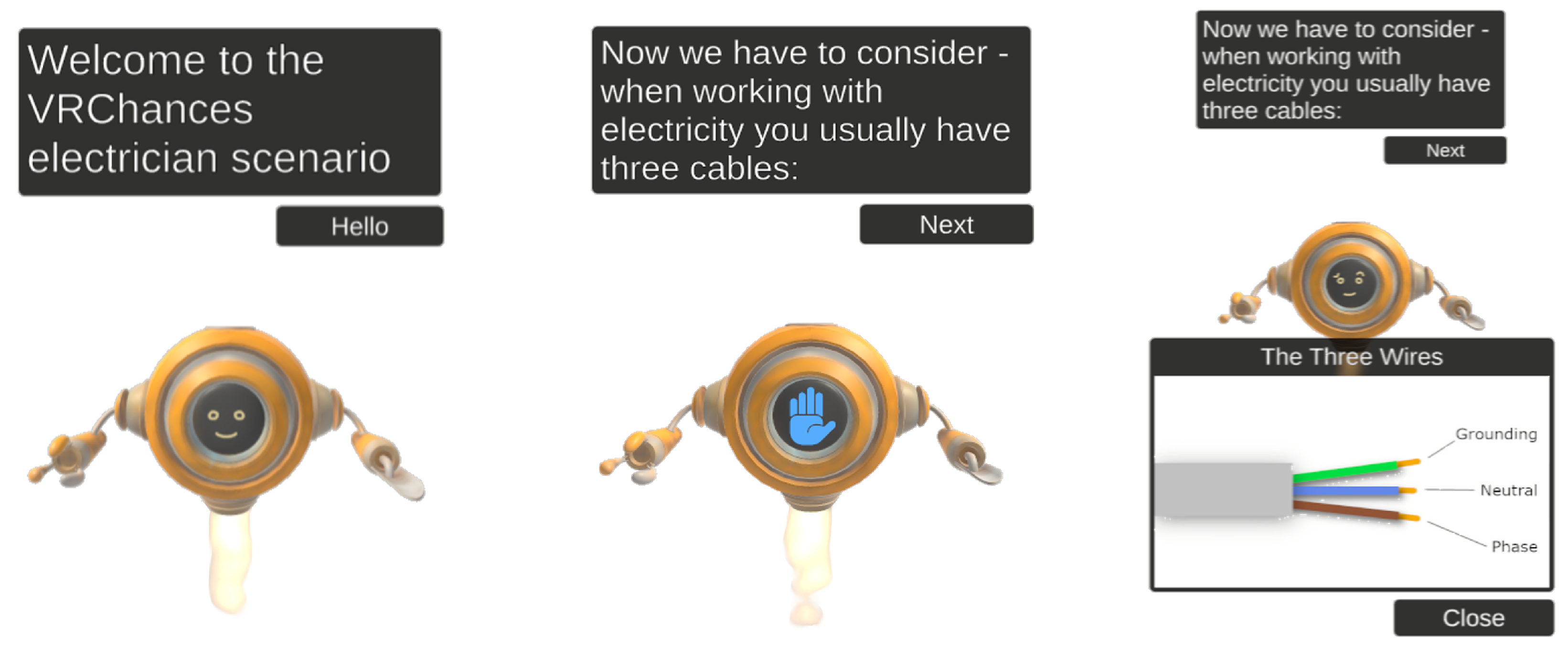
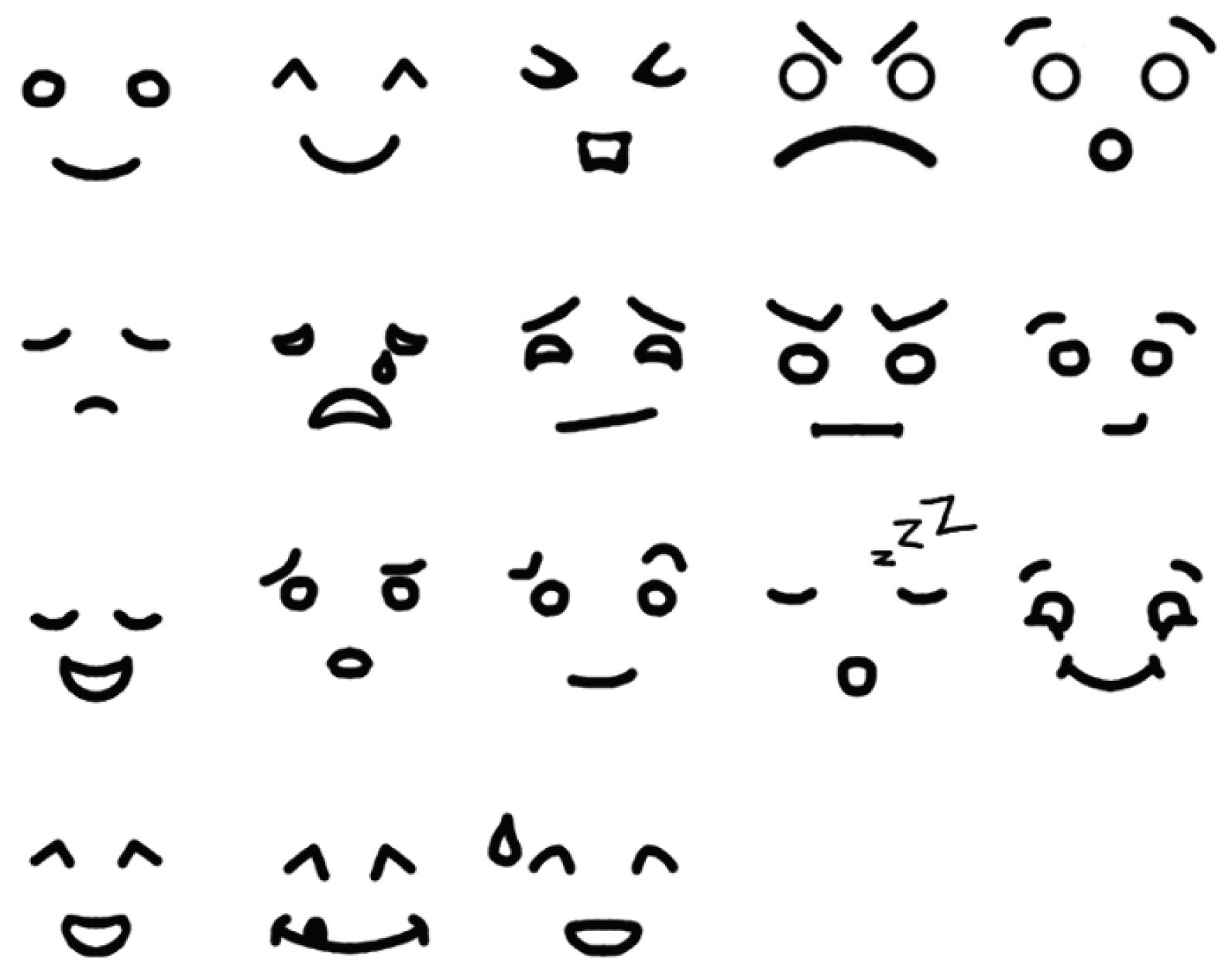
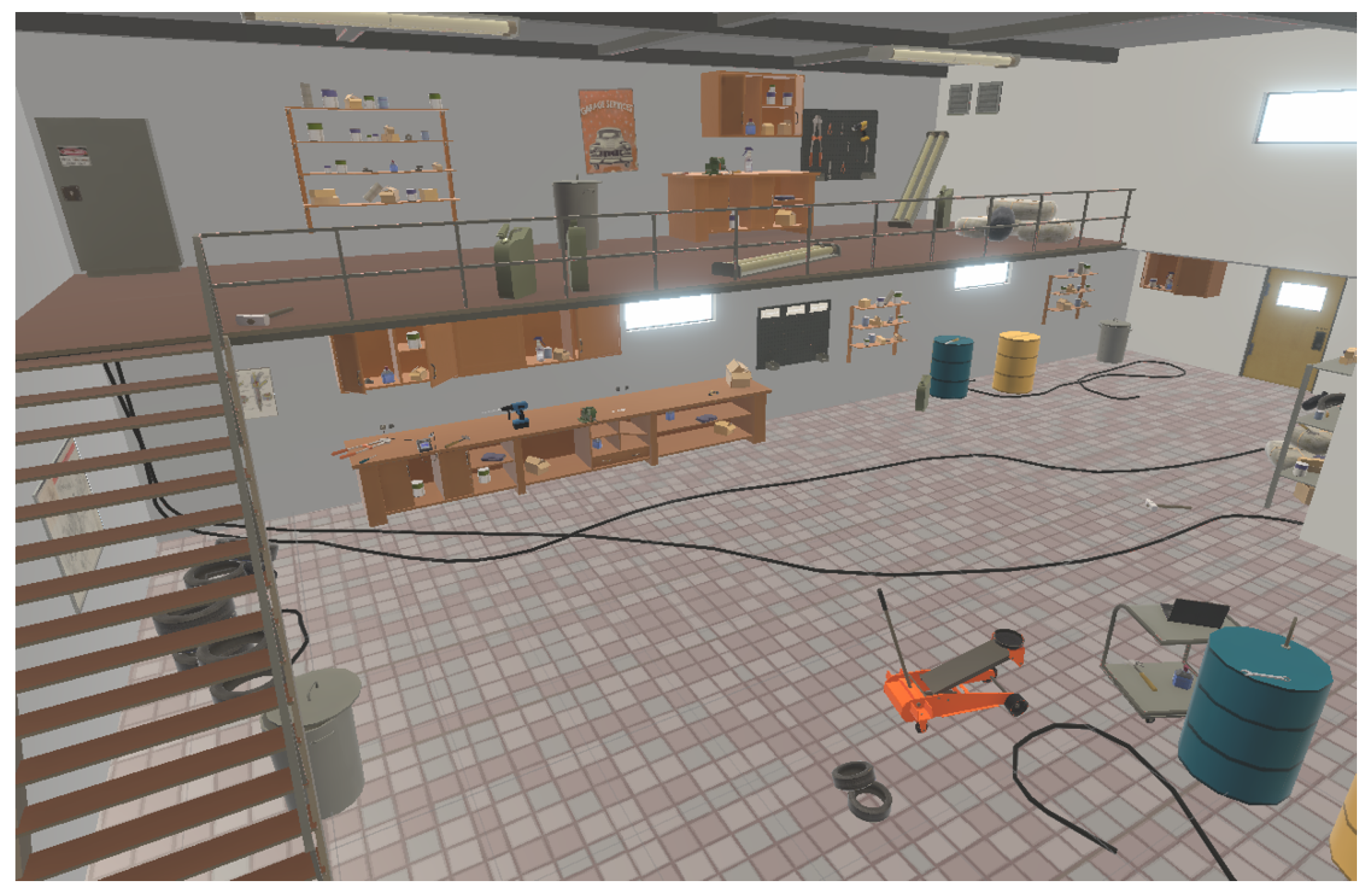

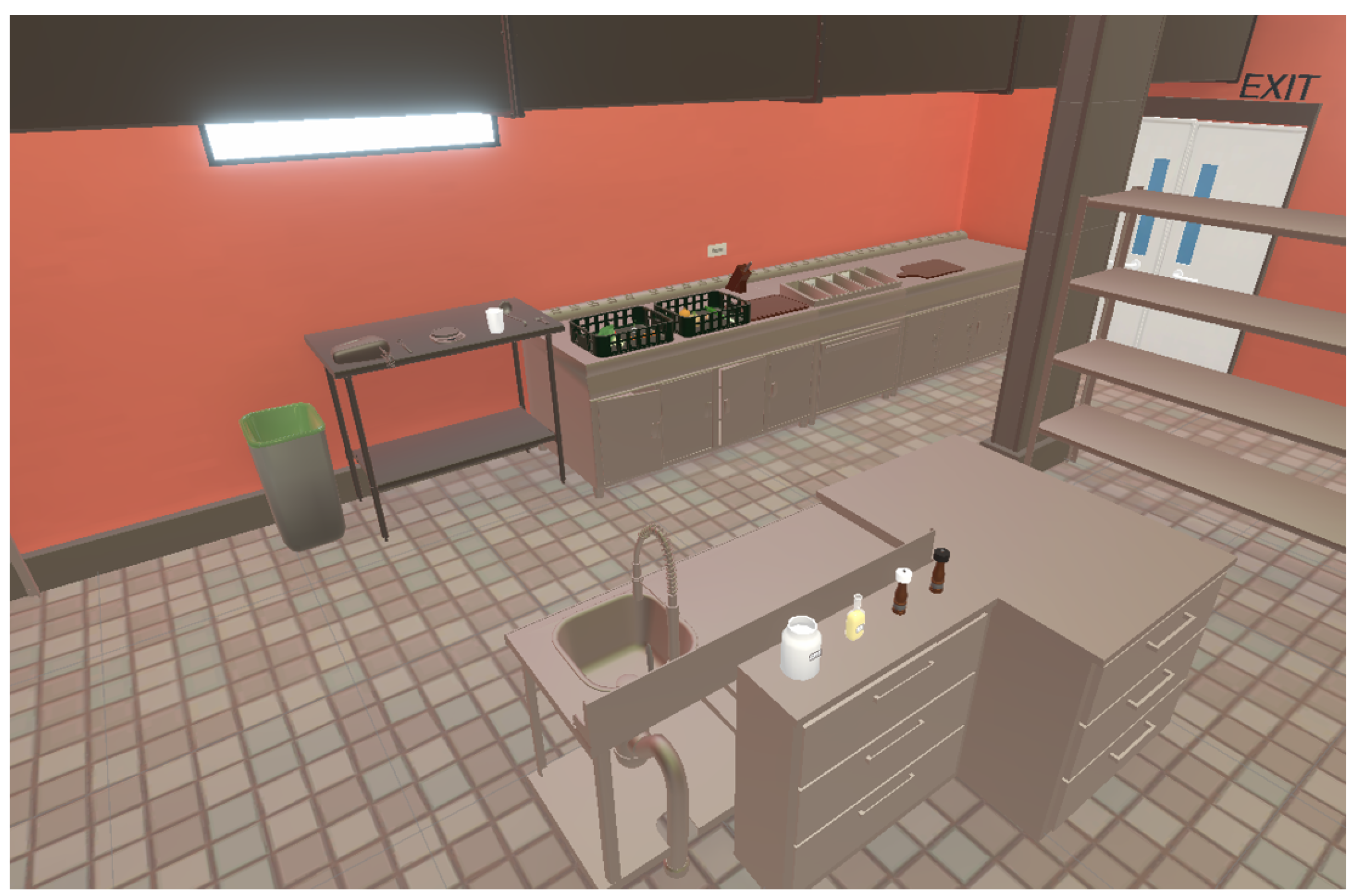
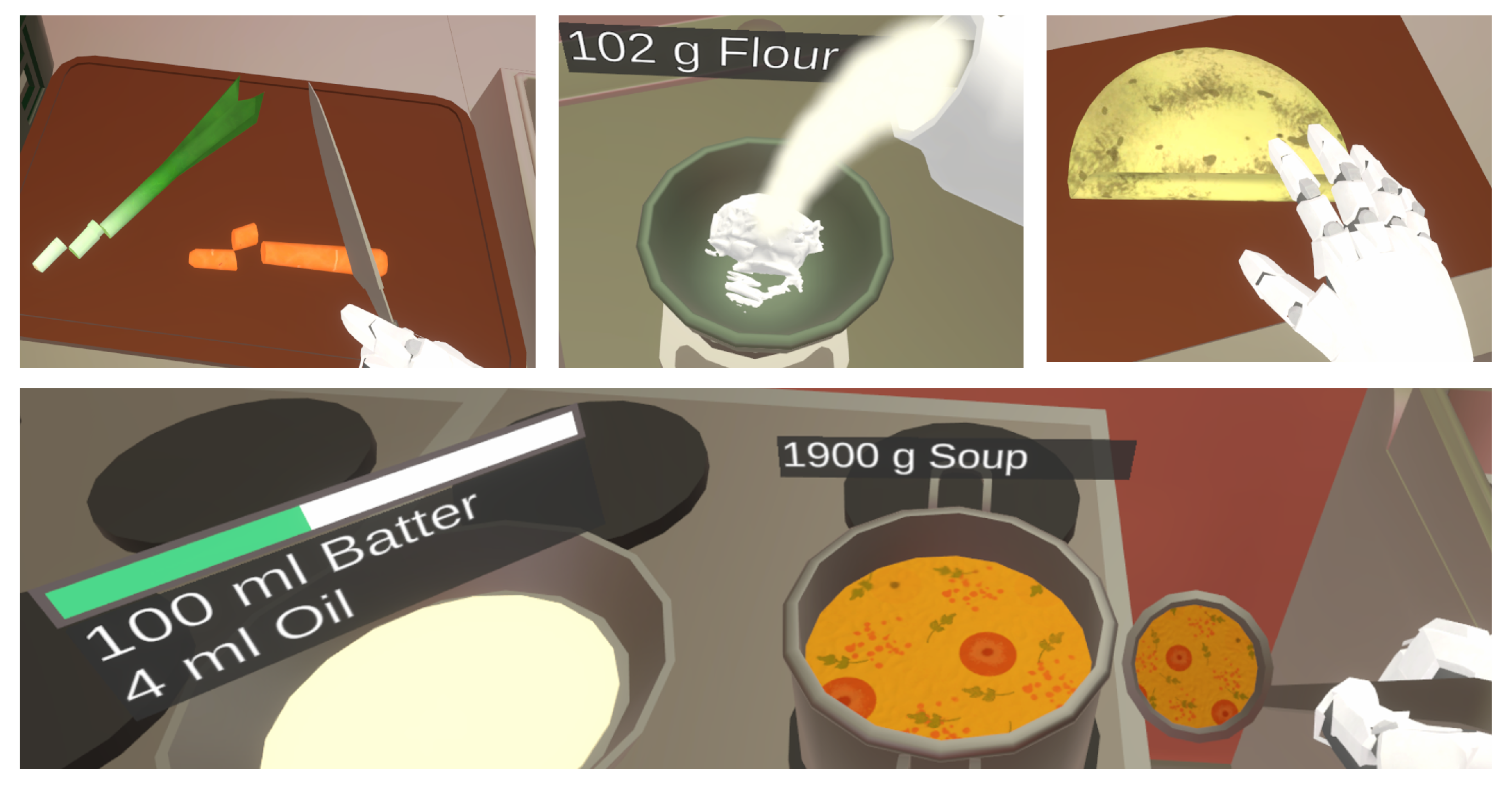


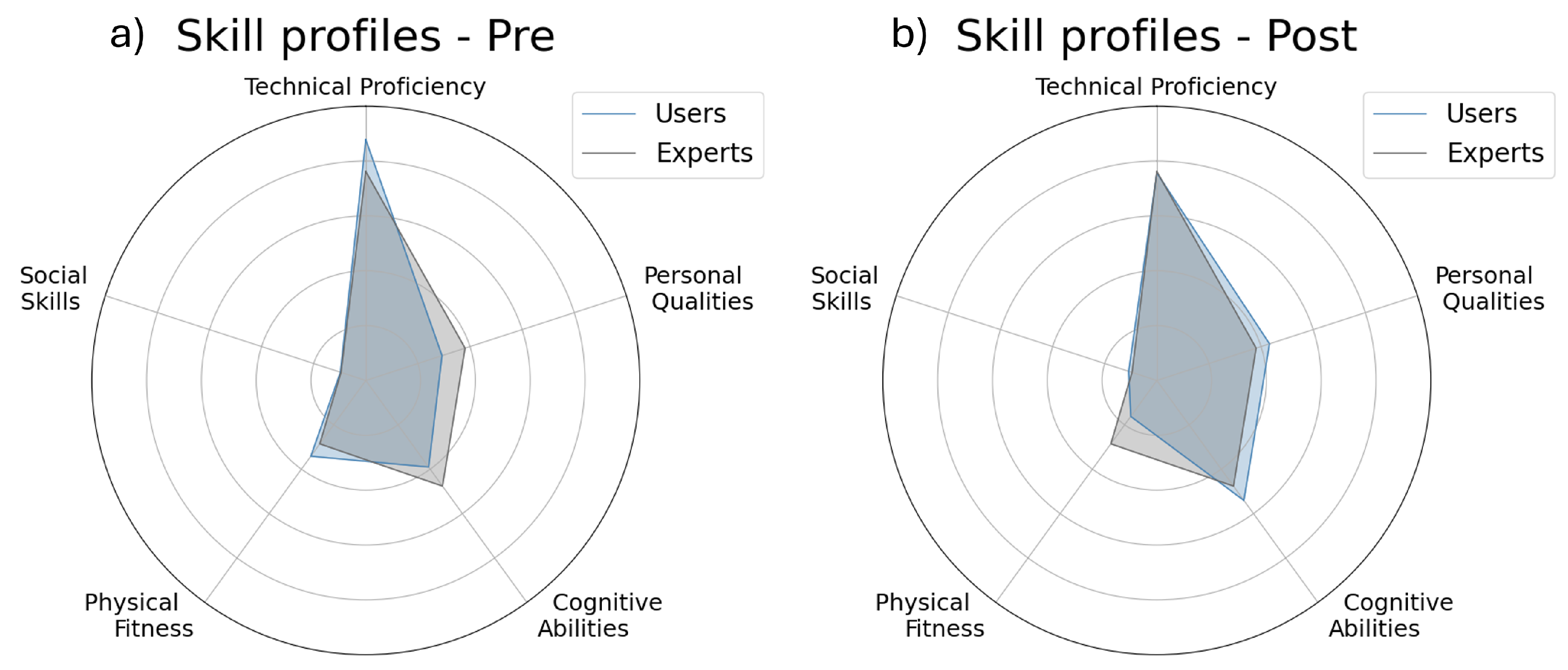
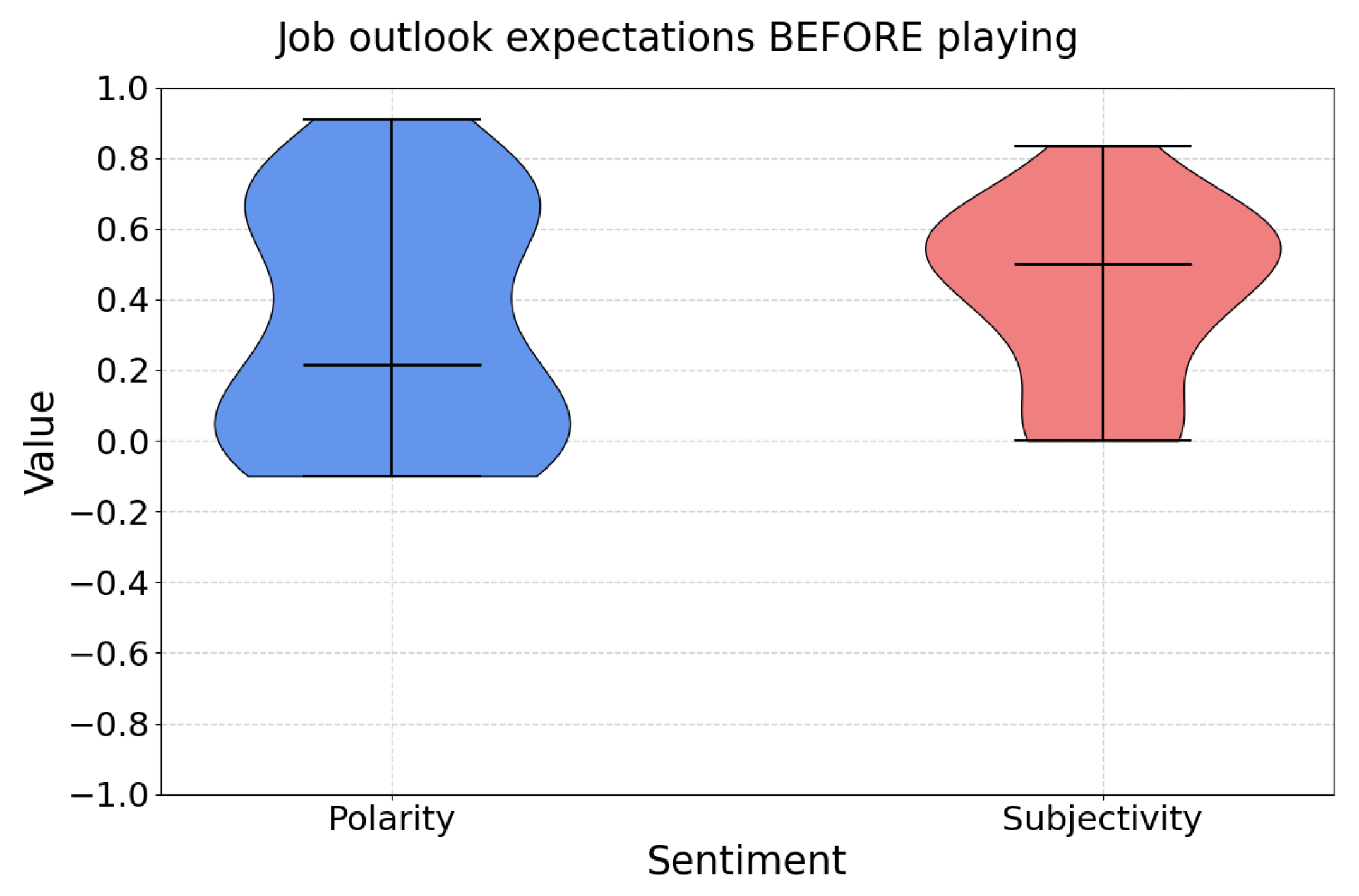
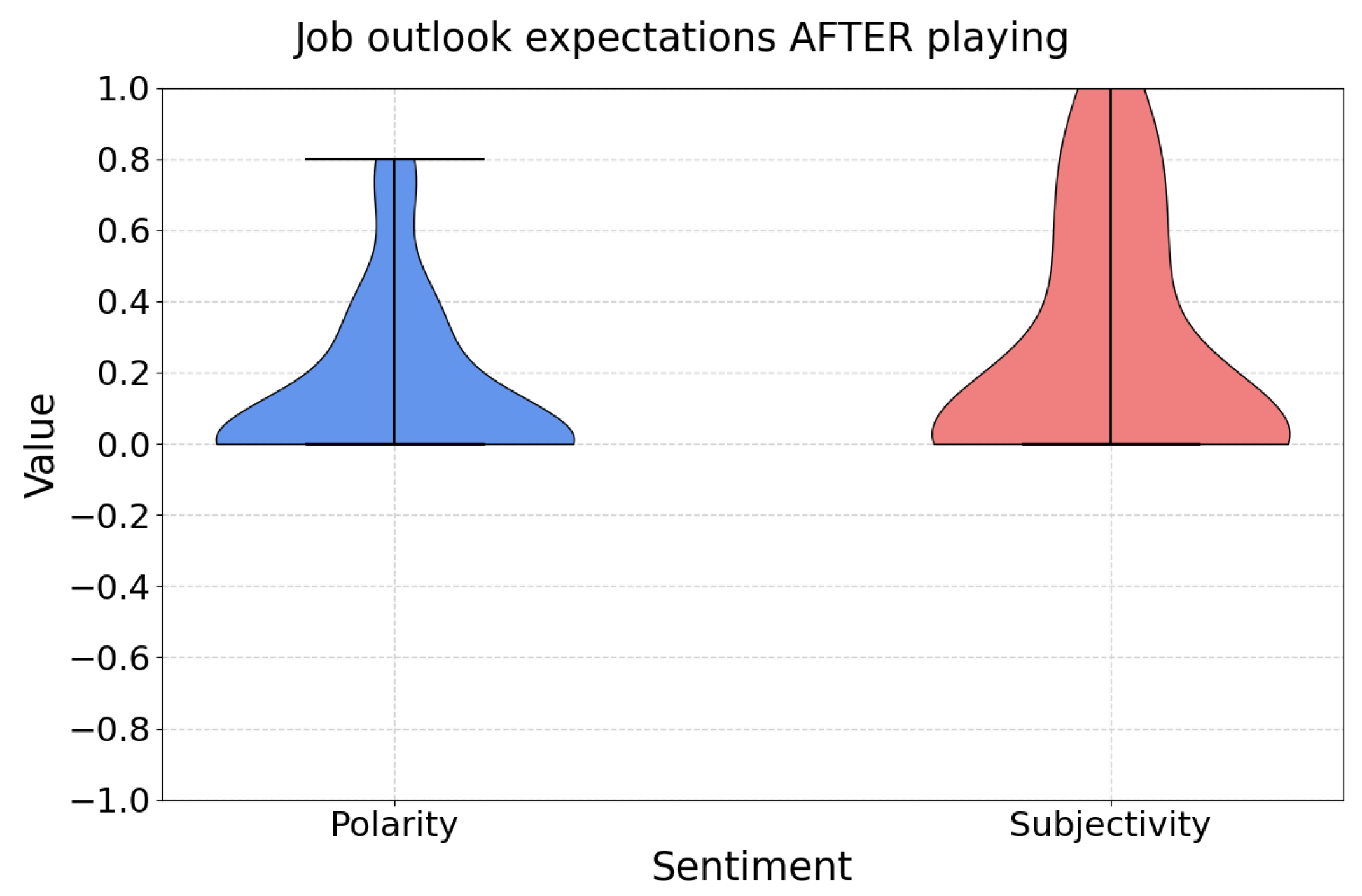

| Level of | Experience with … | ||||||
|---|---|---|---|---|---|---|---|
| Age | Gender | Education | Computers | Video Games | VR | Electrician | |
| C1 | 27 | F | Uni | 3 | 2 | 1 | 2 |
| C2 | 37 | F | Uni | 4 | 1 | 2 | 3 |
| C3 | 46 | F | Uni | 4 | 1 | 2 | 1 |
| C4 | 56 | F | Other | 3 | 2 | 2 | 3 |
| C5 | 28 | M | Other | 4 | 4 | 2 | 3 |
| E1 | 47 | M | LSE | 3 | 4 | 3 | 4 |
| E2 | 58 | M | Uni | 2 | 1 | 1 | 4 |
| E3 | 41 | M | LSE | 3 | 2 | 2 | 4 |
| Item | Coaches | Electricians | ||
|---|---|---|---|---|
| AVG | SD | AVG | SD | |
| I was satisfied with the application. | 3.20 | 0.45 | 4.33 | 0.58 |
| It is a good idea to use this application for career guidance. | 4.60 | 0.55 | 4.67 | 0.58 |
| It is a good addition to regular career guidance methods. | 4.60 | 0.55 | 4.67 | 0.58 |
| The content was well selected and was in line with the objective. | 4.80 | 0.45 | 4.67 | 0.58 |
| The content was presented in a clear and structured way. | 3.60 | 0.89 | 4.33 | 0.58 |
| I would recommend this application. | 4.40 | 0.55 | 4.67 | 0.58 |
Disclaimer/Publisher’s Note: The statements, opinions and data contained in all publications are solely those of the individual author(s) and contributor(s) and not of MDPI and/or the editor(s). MDPI and/or the editor(s) disclaim responsibility for any injury to people or property resulting from any ideas, methods, instructions or products referred to in the content. |
© 2024 by the authors. Licensee MDPI, Basel, Switzerland. This article is an open access article distributed under the terms and conditions of the Creative Commons Attribution (CC BY) license (https://creativecommons.org/licenses/by/4.0/).
Share and Cite
Holly, M.; Weichselbraun, C.; Wohlmuth, F.; Glawogger, F.; Seiser, M.; Einwallner, P.; Pirker, J. VRChances: An Immersive Virtual Reality Experience to Support Teenagers in Their Career Decisions. Multimodal Technol. Interact. 2024, 8, 78. https://doi.org/10.3390/mti8090078
Holly M, Weichselbraun C, Wohlmuth F, Glawogger F, Seiser M, Einwallner P, Pirker J. VRChances: An Immersive Virtual Reality Experience to Support Teenagers in Their Career Decisions. Multimodal Technologies and Interaction. 2024; 8(9):78. https://doi.org/10.3390/mti8090078
Chicago/Turabian StyleHolly, Michael, Carina Weichselbraun, Florian Wohlmuth, Florian Glawogger, Maria Seiser, Philipp Einwallner, and Johanna Pirker. 2024. "VRChances: An Immersive Virtual Reality Experience to Support Teenagers in Their Career Decisions" Multimodal Technologies and Interaction 8, no. 9: 78. https://doi.org/10.3390/mti8090078
APA StyleHolly, M., Weichselbraun, C., Wohlmuth, F., Glawogger, F., Seiser, M., Einwallner, P., & Pirker, J. (2024). VRChances: An Immersive Virtual Reality Experience to Support Teenagers in Their Career Decisions. Multimodal Technologies and Interaction, 8(9), 78. https://doi.org/10.3390/mti8090078







